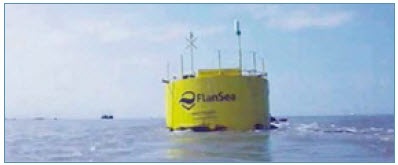BELGIUM
KEY R&D INSTITUTIONS AND RELEVANT R&D PROJECTS
|
The FlanSea project (2010-2013) aimed at designing and developing a wave energy converter for low to moderate wave energy in the Belgian part of the North Sea (and other moderate wave zones). The project partners were DEME blue energy, Cloostermans, Harbour of Ostend, Electrawinds, Spiromatic, Contec and 4 research groups from the University of Ghent. The project has been partly funded by IWT (Flemish Agency for Innovation by Science and Technology). |
 FlanSea device at sea (Flanders Electricity from the sea, www.flansea.eu) |
The FlanSea prototype device of 4.4m diameter, 5m height and 25 tonnes weight was commissioned FlanSea device at sea outside the Harbour of Ostend in July 2013. It has to be considered as a scale model at scale ½. The sea test ended in December 2013. Results have been analysed within PhD scholarships and master theses. The plans and intentions for FlanSea II are currently under development.
|
The Laminaria technology could be classified as a surge operated point absorber. The device consists of a cross shaped buoy tethered to the seabed. The horizontal translation and tilting motion of the hull is transferred through the mooring lines to the Power Take-Off. The unique selling point of the technology is its active storm protection system. Through the use of the storm protection strategy the device can survive any storm with energy production at nominal power. The device achieves this by regulating its exposure to the passing wave energy. In normal operations the device sits in the water with its top near the surface. When wave power exceeds the level necessary to produce nominal power the device submerges. The device finds the ideal height in the water column where there is still enough motion in the water to produce nominal power but without undergoing the excessive motion near the water surface. This results in a very effective way of regulating energy input into the device. As a result of the storm protection strategy the device can be optimized to produce optimal in smaller more common waves. This not only results in a lighter, cheaper and more effective device, it also results in a very high capacity factor. Over the last year a fully functional ¼ scale prototype has been tested at the sea testing site in Ostend, Belgium. The sea trials have shown the storm protection strategy to be very effective. The device was designed to deliver nominal power of 1kW at 0.5m waves. Even though it survived stormy conditions with waves up to 2.7m that have an energy content of 46 times the waves needed to produce nominal power. Due to the storm protection strategy strains and forces on the device and moorings were limited to the level comparable with 0.5m waves. During the sea trials a wave to mechanical efficiency of up to 81% was achieved. |
 Laminaria device at the dock (http://www.laminaria.be/) |
In 2015, a new research project into a novel PTO type started. Cofely Fabricom and Ghent University partnered up and managed to obtain national and international (HIE-WES) funding. Their concept focuses on delivering high power quality, by transforming the oscillatory wave motions into a steady, one-directional rotation of the generator axis. The project consists of a detailed numerical study and the construction of a laboratory test set-up.



